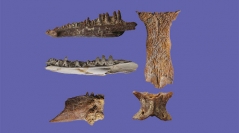

 Comptes Rendus Palevol
22 (24) - Pages 497-510
Comptes Rendus Palevol
22 (24) - Pages 497-510Taphonomic analyses are of primary importance to understand the accumulation processes of fossil vertebrate bone assemblages. These approaches are fundamental in archaeological contexts in which the role of humans in the formation of an accumulation must be investigated in detail. However, taphonomic works have so far focused on temperate regions and mammals and few studies extensively deal with other vertebrates, especially the herpetofauna, and tropical areas. This results in an important gap in the scientific literature, which has a strong impact on the paleoecological and zooarchaeological research in the areas where squamates and amphibians are well-represented. In this paper, we present a detailed taphonomic study of a large herpetofaunal assemblage of nearly 11 000 bones collected in the Abri Cadet 3, on Marie Galante Island, and dated from the beginning of the Holocene to the Amerindian period. Obtained results don’t support the role of humans in the constitution of the assemblage despite the occurrence of clear archaeological layers in the site. The most-likely culprit for the creation of the bone assemblage is a small nocturnal raptor (i.e., Athene cunicularia guadeloupensis (Ridgway, 1874) or Tyto insularis (Pelzeln, 1872)). We also conduct a comparison with the other available deposits from Marie Galante, highlighting the diversity of accumulation processes in the different nearby cave sites but also the lack of detailed taphonomic studies which would be needed to explain this diversity.
Amphibians, squamates, paleoecology, predation, taphonomy, West Indies